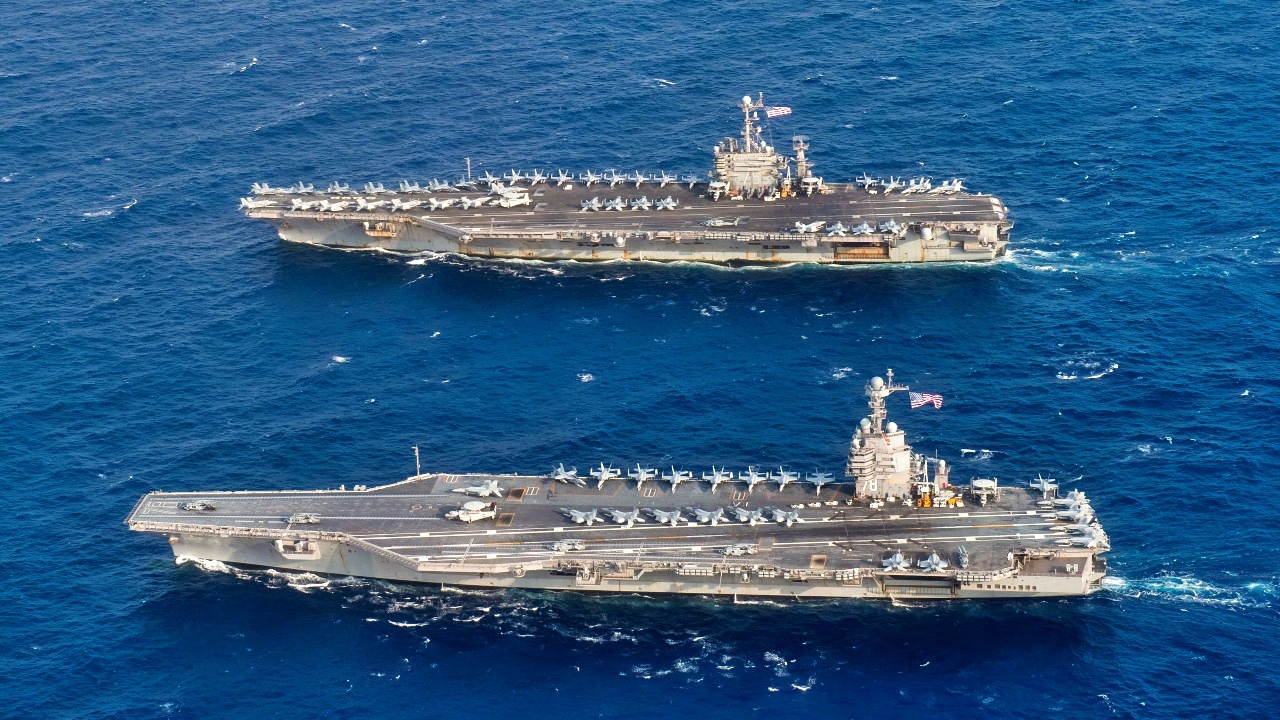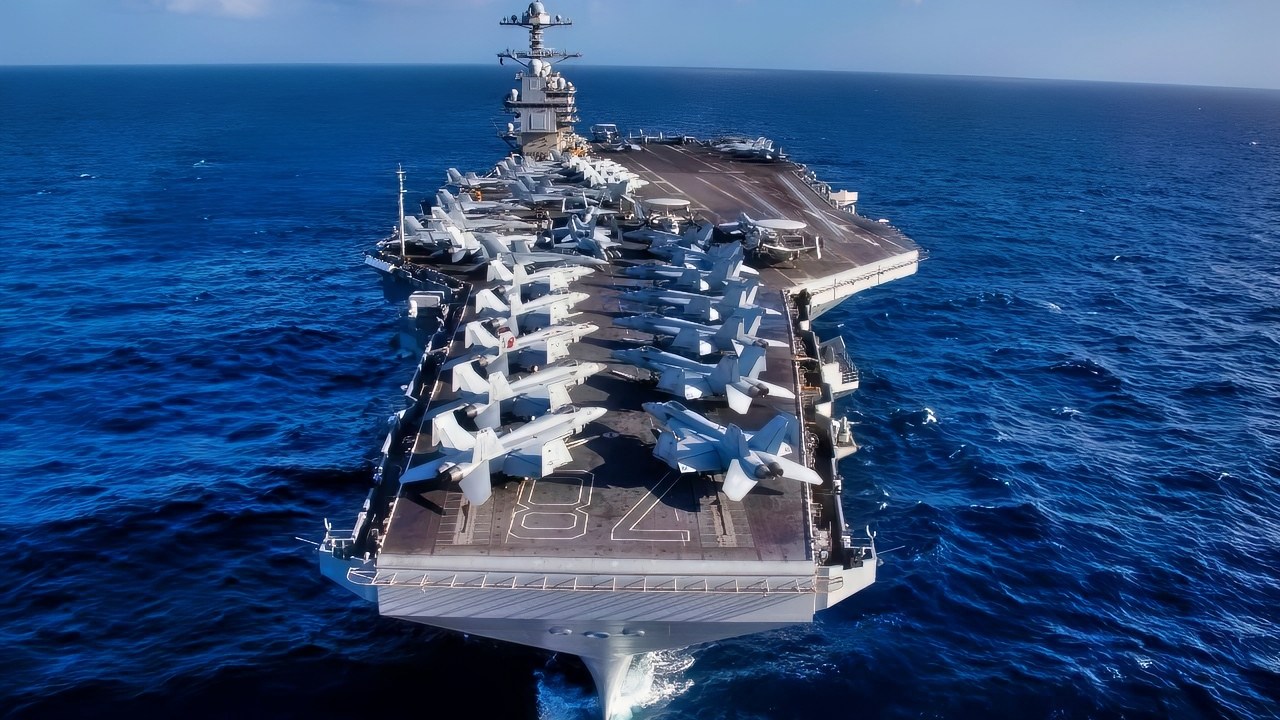Key Points and Summary – U.S. supercarriers remain unmatched power projectors, yet maintenance cycles often sideline them.
-The Navy’s “rule of thirds” keeps only a few deployed while others prep or undergo overhaul. Every 25 years, carriers enter a Refueling and Complex Overhaul (RCOH) that swaps systems and reactors—work that can stretch timelines.

Essex-Class. Image Credit: Creative Commons.

The U.S. Navy Gerald R. Ford–class aircraft carrier USS Gerald R. Ford (CVN-78) and the Nimitz-class aircraft carrier USS Harry S. Truman (CVN-75) underway in the Atlantic Ocean on 4 June 2020, marking the first time a Gerald R. Ford–class and a Nimitz-class aircraft carrier operated together underway.
-USS Harry S. Truman’s collision repairs will fold into RCOH; USS George Washington spent 2,100 days out. With only four public shipyards, shortages of skilled labor, high costs, supply-chain friction, and COVID-era disruptions compound delays.
-The result: world-class deterrence constrained by industrial capacity—raising the question: power projectors or hangar queens?
Nimitz and Ford-Class Aircraft Carriers: Power Projectors or Hangar Queens?
Although some would argue that aircraft carriers have already been rendered obsolete by ship-killing missiles, they remain the U.S. Navy’s ultimate power projectors.
This is especially true of the venerable and time-honored Nimitz-class supercarriers (CVNs) and their successors, the Gerald R. Ford-class CVNs.
The Nimitz- and Ford-class warships are marvels to behold, both for their sheer size and their technological capabilities.
The downside is they need constant maintenance. Which begs the question: Are these supercarriers being relegated to mere “hangar queens” (or “dock dwellers,” if you prefer)?
A highly useful source of information on the carriers’ maintenance woes is an October article for Not What You Think Official website, titled “Why the United States Navy is Facing a Carrier Shortage.”

USS John C. Stennis Carrier. Image Credit: Creative Commons.

The aircraft carrier USS Gerald R. Ford (CVN 78) completes the first scheduled explosive event of Full Ship Shock Trials while underway in the Atlantic Ocean, June 18, 2021. The U.S. Navy conducts shock trials of new ship designs using live explosives to confirm that our warships can continue to meet demanding mission requirements under harsh conditions they might encounter in battle. (U.S. Navy photo by Mass Communication Specialist 3rd Class Riley B. McDowell)
USN Carrier Rotation Rules and Regulations
Navy logisticians apply a “rule of thirds” to work on carriers: At any given time, one-third of carriers are deployed, one-third are preparing for deployment, and one-third are undergoing maintenance. With 11 carriers in the fleet, this means that only three to four are typically out to sea.
At the time the NWYTO article was published, only the USS Dwight D. Eisenhower (CVN-69) and USS Abraham Lincoln (CVN-72) were actually deployed, “highlighting the apparent shortage” even more drastically.
Since then, the USS Gerald R. Ford (CVN-78) has been added to the list, tasked with helping to kill alleged drug-smuggling boats.
RCOH Rigamarole for Aircraft Carriers
CVNs are required to undergo a refueling and complex overhaul (RCOH) every 25 years. This procedure entails cutting a massive hole into the hull and replacing everything from catapult systems to water purifiers.
A prime example of how frustratingly slow repairs and maintenance can be is the USS Harry S. Truman (CVN-75). In February, the Truman collided with the Panamanian-flagged bulk carrier M/V Besiktas-M while the two star-crossed vessels were transiting near Port Said, Egypt, at the northern end of the Suez Canal.
Fortunately no physical casualties were incurred, though the embarrassing incident did end the career of the Truman’s skipper, Capt. Dave Snowden.
The bulk of visible damage to the American vessel affected the starboard side aft of elevator 3, damaging the underside of a sponson with one of the carrier’s .50 caliber machine guns. External damage was also observed at the line handling space, the fantail, and the platform above one of the storage spaces.
Further damage was observed by the exterior wall of two storage rooms and a maintenance space.
Immediately following the collision, the Truman underwent partial repairs at Naval Support Activity Souda Bay in Greece. As part of an Emergent Repair Availability assessment new bulkheads were installed inside each of the damaged spaces to establish weathertight integrity. But the carrier and her crew did not have time to undergo full repairs, as the ship was called upon to fight the Houthis in Yemen.
Fast-forward to October, and, according to Howard Altman of The War Zone, CVN-75 was finally scheduled for the completion of her repair work—it will take place as part of her RCOH procedure at the Newport News Shipbuilding docks.
The process is expected to take place in the next 11 months, but no date has been announced.
Delays in the RCOH process have extended repair times for at least one other Nimitz-class carrier: The USS George Washington (CVN-73) was out of action for a whopping 2,100 days.
Why Do the Dock Dweller Delays Drag On?
The aforementioned NWYTO article sheds additional light on why carrier maintenance takes so long:
-The Navy has a measly four national shipyards capable of carrying out carrier repairs (a sad reflection on just how much American shipbuilding capability has declined in the post-Cold War era). Many experienced workers have retired, and new hires lack hands-on expertise.
The nightmarish COVID-19 lockdowns disrupted production and maintenance even further, creating multi-year delays that continue to affect readiness throughout the fleet.
-Maintenance bottlenecks have been caused by high costs, staff shortages, supply chain issues, and lengthy construction and repair times.
About the Author: Christian D. Orr, Defense Expert
Christian D. Orr is a Senior Defense Editor. He is a former Air Force Security Forces officer, Federal law enforcement officer, and private military contractor (with assignments worked in Iraq, the United Arab Emirates, Kosovo, Japan, Germany, and the Pentagon). Chris holds a B.A. in International Relations from the University of Southern California (USC) and an M.A. in Intelligence Studies (concentration in Terrorism Studies) from American Military University (AMU). He is also the author of the newly published book “Five Decades of a Fabulous Firearm: Celebrating the 50th Anniversary of the Beretta 92 Pistol Series.”
More Military
Russia’s Mach 2 Su-30SM Fighter Has A Message for Any Air Force on Earth
The Mach 2.2 B-1A Bomber Has A Message for the U.S. Air Force
The Mach 2.35 ‘Super’ Eurofighter Typhoon Fighter Has a Message for Any Air Force On Earth
Canada’s CF-18 Hornet Fighter Crisis
Forget NGAD or the J-20: A 7th Generation Fighter Could Hit Mach 5










